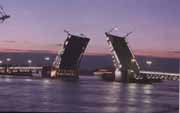|
|
|
St. Petersburg — from the time of Peter the Great to our days
 Initially there was a river: The city began from the Neva whose shores presented an ideal place to build a fortress, laid here by Peter the Great during the Northern War. The new fortress was called "Saint Petersburg" in the honour of the apostle Peter — custodian of keys of the gate to paradise and the heavenly patron of the emperor. 16th May 1703 is considered the day of foundation of St. Petersburg Initially there was a river: The city began from the Neva whose shores presented an ideal place to build a fortress, laid here by Peter the Great during the Northern War. The new fortress was called "Saint Petersburg" in the honour of the apostle Peter — custodian of keys of the gate to paradise and the heavenly patron of the emperor. 16th May 1703 is considered the day of foundation of St. Petersburg
In 1710 the capital was transferred from Moscow to St. Petersburg, and in 1712 the Tsar's family, the Court and the state establishments appeared here.From the very beginning of St. Peteresburg's construction Peter the Great aspired to create a "regular city" with a concise layout, built up to the standards of other such projects — a replica of Amsterdam or Venice. Executing the Emperor's order, architects J. B. Leblond and Domenico Trezzini elaborated the general plans of the new capital's housing scheme. The Summer Garden of Peter the Great, the building of "twelve collegiums", the Kunstkammer, the Palace of Menshikov were also built.Works of reconstruction of the central part of the city and the suburbs continued during the rule of Paul 1 (1796–1801). Michailovsky castle — an enigmatic building of St. Petersburg, wrapped in mysteries and legends, was erected.
Russia's victory over the troops of Napoleon in 1812 was reflected in the new uplift of construction works in the city on the Neva. In these years the Michailovsky palace and the Alexander theatre ensembles, buildings of Russian state establishments — Senate and Synod, the building of the main headquarters and the ministries on the Palace square were constructed. The Palace square ensemble was accomplished by erecting the granite Alexander column.
Reign of Nicholas 1 (1825–1855) is marked by the development of industry. St. Petersburg becomes the centre of Russian industrial capitalism.
 By the beginning of the 20th century St. Petersburg became a European city in the proper sense of the word. The industry of St. Petersburg produced nearly everything that such a big state, as Russia required — from the most up-to date arms to any products of light industry.At the same time, the city grew more and more comfortable in its place of residence. Dozens of bridges connected the islands on which St. Petersburg is situated. Several railway lines linked the capital to different parts of the country's [A. Beggrov. Nevsky prospect]regions and to European countries.Tramway came into being in 1907 and immediately became the main and the best mean of transport for the residents of St. Petersburg, solving many city problems, the population of which kept growing. At the beginning of the 20th century St. Petersburg population growth rate prevailed over that of Paris, London and even New York. By the beginning of the 20th century St. Petersburg became a European city in the proper sense of the word. The industry of St. Petersburg produced nearly everything that such a big state, as Russia required — from the most up-to date arms to any products of light industry.At the same time, the city grew more and more comfortable in its place of residence. Dozens of bridges connected the islands on which St. Petersburg is situated. Several railway lines linked the capital to different parts of the country's [A. Beggrov. Nevsky prospect]regions and to European countries.Tramway came into being in 1907 and immediately became the main and the best mean of transport for the residents of St. Petersburg, solving many city problems, the population of which kept growing. At the beginning of the 20th century St. Petersburg population growth rate prevailed over that of Paris, London and even New York.
The renaming of St. Petersburg Petrograd in 1914 came as a result of anti-German moods in the society.Petrograd became the centre for the dramatic events of 1917. "The city of three revolutions" has several symbolic monuments: Smolny, the cruiser Aurora and the Field of Mars.In 1924 after Lenin's death the Bolsheviks renamed the city, Leningrad.The Great Patriotic War (1941–1945) became the hardest trial for Leningrad. During the 900-days siege 1941–1944 about 1 million inhabitants of St. Petersburg perished from cold, hunger and bombardments. But the city outstood, it has never been occupied or won by anyone. Seriously damaged by the fascist bombing, the city was fully restored by 1950–1960.In 1991 historic justice prevailed and the city on the Neva was returned its original name — St. Petersburg.
St. Petersburg today is a multifunctional city centre with immense potential for investment, tourism and international relationship development.City construction is in full swing, its infrastructure is being developed and improved: the city centre is being restored, new subway stations are being constructed with the help of unique technologies, the bridges across the Neva are being rejuvenated, sport and leisure complexes are being created; the Hermitage, the Russian museum, Yusupov palace have already been renewed.
|